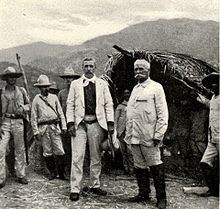Cuban War for Independence
| Cuban War of Independence | |||||||
|---|---|---|---|---|---|---|---|
 Calixto García, a general of Cuban rebel forces, (right) with American Brigadier General William Ludlow with Cuban rebels in the background, 1898. |
|||||||
|
|||||||
| Belligerents | |||||||
|
|
|||||||
| Commanders and leaders | |||||||
|
|
|
||||||
| Strength | |||||||
| 240,000 regulars and 60,000 Volunteers Corps (irregulars) (in 1897) | not defined | ||||||
| Casualties and losses | |||||||
| 4,032–9,413 died in battle + 40,000 dead from disease |
5,180 Cuban insurgents died in combat 3,437 Cuban insurgents dead from disease 385 US soldiers died in combat 2,061 US soldiers dead from disease |
||||||
| 300,000 total Cubans dead (mostly famine and disease) | |||||||
Cuban victory
The Cuban War of Independence (1895–1898) was the last of three liberation wars that Cuba fought against Spain, the other two being the Ten Years' War (1868–1878) and the Little War (1879–1880). The final three months of the conflict escalated to become the Spanish–American War, with United States forces being deployed in Cuba, Puerto Rico, and the Philippine Islands against Spain. Historians disagree as to the extent that United States officials were motivated to intervene for humanitarian reasons but agree that yellow journalism exaggerated atrocities attributed to Spanish forces against Cuban civilians.
During the years 1869–1888 of the so-called “Rewarding Truce”, lasting for 17 years from the end of the Ten Years' War in 1878, there were fundamental social changes in Cuban society. With the abolition of slavery in October 1886, freedmen joined the ranks of farmers and urban working class. Many wealthy Cubans lost their property, and joined the urban middle class. The number of sugar mills dropped and efficiency increased: only companies, and the most powerful plantation owners, remained in business followed by the Central Board of Artisans in 1879, and many more across the island. After his second deportation to Spain in 1878, José Martí moved to the United States in 1881. There he mobilized the support of the Cuban exile community, especially in Ybor City (Tampa area) and Key West, Florida. His goal was revolution in order to achieve independence from Spain. Martí lobbied against the U.S. annexation of Cuba, which was desired by some politicians in both the US and Cuba.
...
Wikipedia
